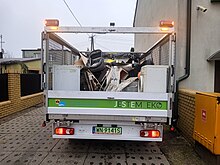| The examples and perspective in this article deal primarily with the United Kingdom and do not represent a worldwide view of the subject. You may improve this article, discuss the issue on the talk page, or create a new article, as appropriate. (July 2012) (Learn how and when to remove this message) |


Bulky waste or bulky refuse is a technical term taken from waste management to describe waste types that are too large to be accepted by the regular waste collection. It is usually picked up regularly in many countries from the streets or pavements of the area. This service is provided free of charge in many places, but often a fee has to be paid.
Bulky waste items include discarded furniture (couches, recliners, tables), large appliances (refrigerators, ovens, TVs), and plumbing fixtures (bathtubs, toilets, sinks). A large amount (30-60%, depending on area) of bulky waste is picked up by scavengers before it is collected. Branches, brush, logs and other green waste are also categorized as bulky waste, although they may be collected separately for shredding and/or composting.
Grapple trucks, also known as knuckleboom loaders, are often used to collect bulky waste. In the UK, refuse collection vehicles (RCVs) or crushers are being increasingly phased out as more bulky waste is diverted for re-use and recycling.